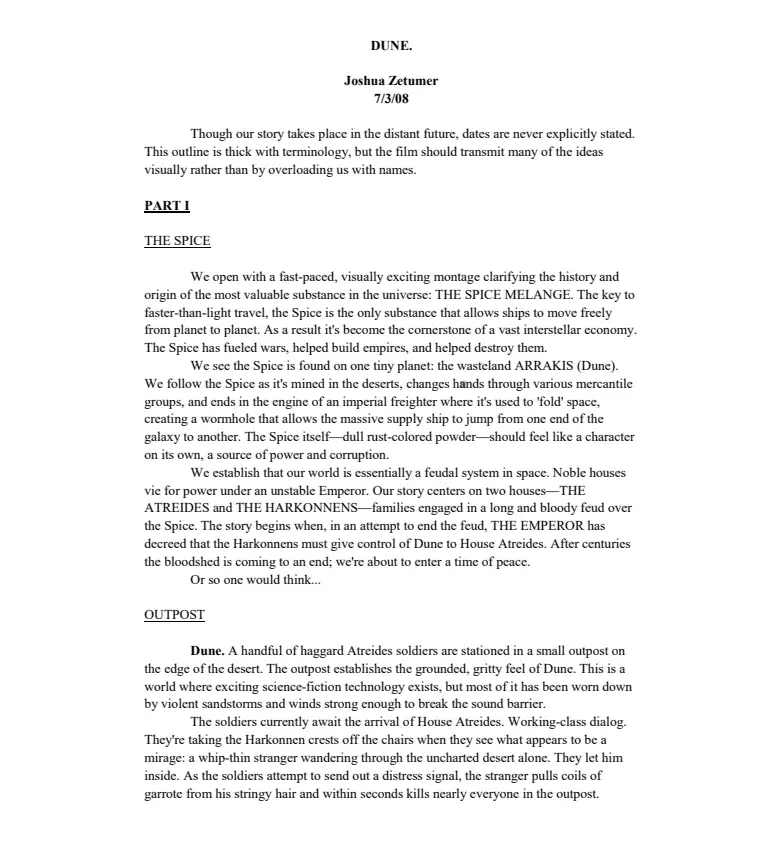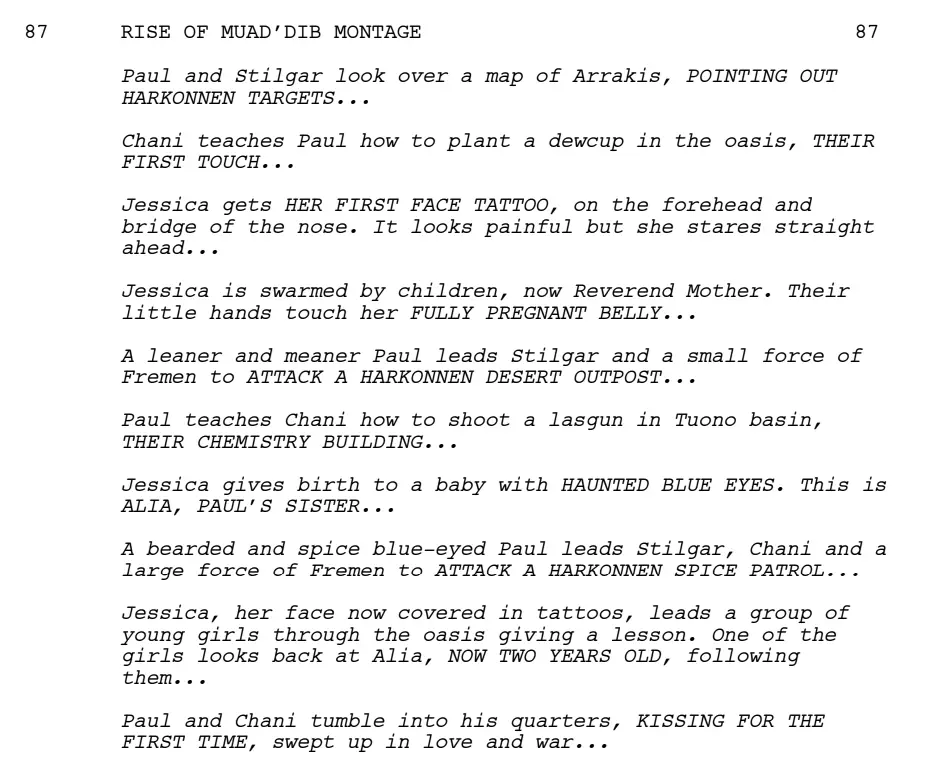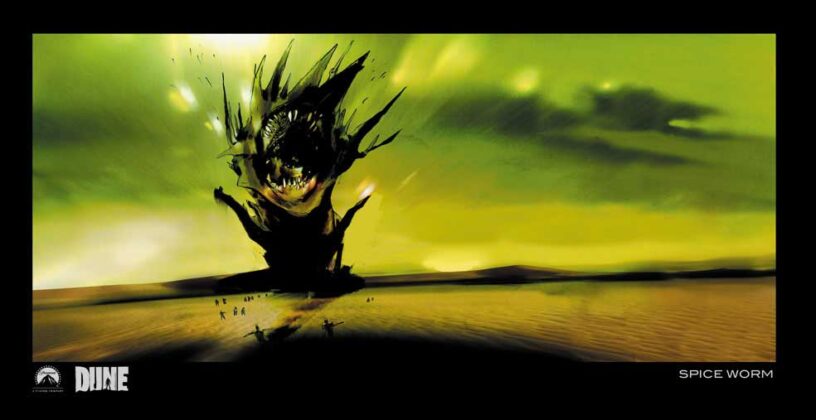In August 2007, Byron Merritt—grandson of Dune author Frank Herbert—posted on a forum that negotiations for a new Dune movie had been in the works for over two years and they were getting very close to making a deal. Later he provided some additional information:
Although only rumor, I’ve heard that ‘someone’ at the studio wants Dune reallllly bad and has been a fan of the novel for ‘years.’ They’re not saying who this is (and it might just be hype) but I’m holding out hope that whoever this might be is a big enough fan that he/she will do the book justice. Supposedly it’s some director.
Byron Merritt – Dune Novels Forum, August 23, 2007
Paramount’s Dune Project Begins
A few months later, in October 2007, Ain’t It Cool News reported that the studio was Paramount Pictures. Their director would be Peter Berg, who had most recently directed The Kingdom (2007).

Just before Christmas, in an interview with MTV Movie Blog, Peter Berg confirmed those rumors, but noted there was no script yet, “if it weren’t for the writers’ strike, we’d be in it right now.” It is curious that a writers’ strike delayed work on Arthur P. Jacob’s Dune and the recent writers’/actors’ strike also delayed the release of Dune: Part Two until 2024.
Berg declared himself “a huge fan of the book” and that the movie would be “big big big.”
Josh Zetumer’s Dune Movie Script
The writers’ strike ended in February 2008, but the hunt for a writer took some time. It wasn’t until June 6, 2008 that The Hollywood Reporter wrote that Josh Zetumer was in negotiations to pen the script. A month later, Zetumer completed a 13-page script treatment, dated July 3, 2008, and reportedly completed a 175-page draft in 2009.

For me, this project was infinitely harder than a spec. I get to a point on most projects where I want to quit/have a near-panic attack. I’m beginning to realize, as horrible as that is, it’s all part of the creative process. It’s like an acid trip; it’s fun, but you know that for at least a couple hours you’re going to be fearing for your life.
On DUNE this was especially intense. The book is amazing, but parts read like physics homework. There’s so much terminology, and so much is internal – characters second-guessing each other, trying to gauge situations. The key for me was to keep saying, ‘What can I do visually to express this idea?’ I feel like this is a pretty important question you should be asking yourself on every screenplay. Show not tell.
Josh Zetumer – The Rouge Wave, April 6, 2009
His treatment breaks down the story in broad strokes and uses many other movies as a point of reference; a dinner party in which the Houses of Atreides, Harkonnen, and Corrino all attend is compared to the opening scene from The Godfather, a ‘thopter chase is “Star Wars by way of Bourne”, and of course Lawrence of Arabia is mentioned.
There are several deviations from the novel, with a footnote suggesting that Duncan and Gurney should be merged into a single character, Chani is the wife of Jamis, and Paul fails when trying to ride a sandworm for the first time.
Joshua Zetumer’s Dune outline can be downloaded from the DuneInfo Script Archive.
Jock’s Concept Artwork
British comic artist Mark Simpson, better known simply as “Jock”, was brought on by Berg to do some concept art, and did a series of pieces for Caladan, Arrakis, Paul, and of course the sandworms. For more of those concepts refer to Jock’s Concept Art for Peter Berg’s Dune on the DuneInfo site.

Excitement and Departure
In May, Berg was rumored to have spoken to Robert Pattinson (aged 23 at the time) about playing Paul Atreides, although Berg later said that he was looking for someone in their “late teens” for the lead role and was excited by the “franchise potential” should the first movie be a success.
I found it to be more of an adventure tale, more of a muscular action/adventure story. I think that’s my approach, not as an R-rated film, but as a pretty hard PG-13 film about a young man dealing with issues of vengeance over the death of his father and wanting some payback and having to come to terms with his destiny along the way.
Peter Berg – MTV Movie Blog, September 14, 2009
But by October 2009 Peter Berg and his production company (Film 44) had dropped out of the Dune project completely. Berg’s next film was Battleship (2012) which, along with his comments about this planned Dune movie being a “muscular action/adventure story”, led some Dune fans to feel like they had dodged a hunter-seeker with his departure.
Pierre Morel Takes the Director’s Chair
Paramount searched for a new director, at first considering Neill Blompkamp (District 9) and Neil Marshall (The Descent). However in January 2010 Entertainment Weekly revealed that Pierre Morel (Taken) had been hired, and they were searching for a new writer to incorporate the new director’s vision into the Zetumer draft.
I’ve been a fan of that book – because I will not refer to the movie – I’ve been a fan of the book since I was a teenager. I read that when I was 15, maybe. I’ve been reading it over and over again – well, I’m 45 now, so for 30 years. The fun story, actually, is that there were six books in that first series that Frank Herbert wrote. Every time I was going to buy a new one – because I couldn’t buy all six at one time – I was reading the previous ones so I would not forget anything. So, by the time I bought the sixth book I had already read the first one six times! So, I’m a hardcore fan.
[My Dune movie] is all about the first book. I’m trying to be very respectful to the original novel, but it’s a challenge; there’s a lot of expectation, all the readers will be waiting for me with their shotguns. All the non-readers will also be waiting for us, because it’s such a complex, rich novel and you have to make it accessible to those who have not read the book. So, it’s a tough challenge but I’m very excited about that.
Pierre Morel – MTV Movies Blog, January 11, 2010
Chase Palmer’s Dune Movie Script

The writing challenge landed at the feet of Chase Palmer. By July 2010 he had completed a 120-page script, which—going by the rule of thumb that one page equals one minute of screen time—would have resulted in a movie exactly two hours long!
While the script does touch upon the ecological and prophecy aspects from the novel, it is mainly an action-adventure story. Feyd is a more active character, leading the attack on the Atreides and even killing Duke Leto during the battle—so no poison-gas tooth plot point. Paul and Jessica meet the Fremen exactly half way through the script, and then, like Lynch’s Dune, much of the story is compressed into a montage.

In a major change from the novel, Paul is actually the first person to ride a sandworm, seemingly suggesting that all the sietches were within walking distance of each other! The final battle focuses more on personal conflicts than sandworm-riding Fremen versus Sardaukar. Jessica faces Mohiam, Gurney has his revenge against Rabban, and Paul duels Feyd throughout the Arrakeen palace. Latter scene ends with Feyd being defeated in the throne room, in front of the Emperor, and the movie concludes with Paul marrying Irulan.
Chase Palmer’s Dune script can be downloaded from the DuneInfo Script Archive.
Kevin Jenkin’s Dune Artwork
In 2010 artist Kevin Jenkins worked with Morel creating concept art for the movie. Some of those pieces are available on his website: https://kevjenkins.com/dune

End of the Journey
By November 2010, Morel had—like Berg before him—exited the director’s chair, and was an executive producer on the project. This left Paramount in a race against the clock, as without a firm production start date by spring 2011 the rights would expire. Producer Richard P. Rubinstein told Deadline that “we don’t want to extend an option and watch the studio take seven years.”
Ultimately spring rolled around without any agreement having been reached. The rights expired and Paramount’s four-year journey to adapt Dune came to an end. The studio also lost the six-figure sum it had paid for the rights. Paramount may have been able to salvage some of its development costs had another studio had picked up the script by Palmer, but that didn’t happen. Dune once again slumbered, however fans knew that when the sleeper was awakened the results would be legendary…



